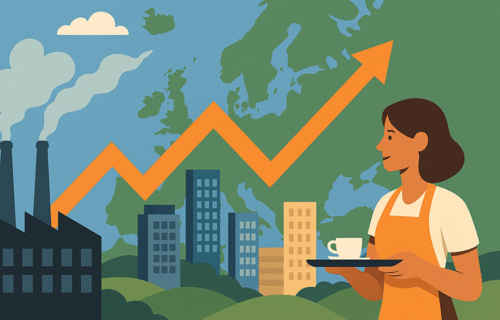Private-sector growth across the eurozone gained fresh momentum in October, recording its fastest pace in more than two years as services demand strengthened and business confidence edged higher. The latest survey data suggest that Europe’s economy may be turning a corner after months of uneven performance, though the rebound remains concentrated in a handful of resilient markets.
Preliminary figures indicate that overall business activity rose for the ninth consecutive month, with the region’s combined output index climbing to roughly 52 points, up from 51 in September. The improvement was strongest in consumer-facing and business-service industries, while manufacturing showed signs of stabilising after a prolonged slump.
Germany, the bloc’s largest economy, led October’s expansion. Activity there rose to levels last seen in early 2023, supported by a robust service sector and signs that factory output may finally be bottoming out. Order books have begun to fill again, particularly among logistics and technology firms, and hiring has returned to modest growth. Economists say the data point to a better-than-expected start to the final quarter of the year for Europe’s industrial powerhouse.
France, by contrast, remains mired in contraction. Output continued to decline for the fourteenth straight month, with both manufacturing and services under pressure from weaker domestic demand and continued political uncertainty over the 2026 budget. Business leaders in Paris and Lyon have reported slower client spending and reduced investment plans, adding to concerns that France could weigh on the wider eurozone recovery if the trend persists.
Outside the two largest economies, results were more balanced. Italy and Spain both maintained moderate expansion in October, supported by steady tourism flows, energy-transition projects and improving domestic services. Their contribution helped offset France’s drag and added to the eurozone’s aggregate growth figure.
Analysts note that the region’s composite indicator for October now stands at its highest since mid-2023, suggesting that Europe’s post-pandemic slowdown may be easing. The upward movement in services output, which reached about 52.5 points, marks the strongest showing in over a year. Manufacturing, although still fragile, has moved closer to neutral territory after a lengthy contraction phase.
Survey respondents reported easing cost pressures for raw materials and intermediate goods, but firms continued to raise selling prices, particularly in the services sector. This pattern implies that consumer inflation could remain sticky even as supply-chain costs stabilise. Economists interpret these results as supporting the European Central Bank’s current wait-and-see stance on interest rates. The ECB left borrowing costs unchanged this month, citing the need for more evidence that inflation is retreating toward its two-percent goal.
Despite the stronger-than-expected business readings, financial markets reacted cautiously. The euro traded little changed near $1.16, while government bond yields moved only slightly higher. Equity indices across the continent were mixed, with investors awaiting new U.S. inflation figures and corporate earnings reports for confirmation of global demand trends.
Overall, the October data portray a two-speed Europe: northern and southern economies showing moderate resilience, France still under strain, and manufacturing only tentatively emerging from weakness. Economists emphasise that sustained recovery will depend on stronger household spending and renewed investment over the coming quarters.
If present momentum holds, the eurozone could close 2025 with its first full-year of consistent private-sector expansion since before the pandemic—though the path ahead remains uneven and dependent on maintaining both price stability and consumer confidence.
Editorial Disclaimer: This article is for informational and analytical purposes only. CIJ.World maintains strict editorial neutrality and verifies all facts at the time of publication.
